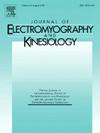Depth sensor technology in facial movement analysis: A comparative evaluation with marker-based motion analysis
IF 2.3
4区 医学
Q3 NEUROSCIENCES
引用次数: 0
Abstract
Objective
This study evaluates the reliability and agreement of depth sensor technology compared to marker-based motion analysis for facial movement assessment. Depth sensors, such as the Kinect-V2, offer a non-invasive alternative, but their accuracy in facial kinematics remains uncertain.
Method
100 healthy participants (50 male, 50 female) performed six facial movements— opening −mouth, smiling, eyebrow-lifting, forced-eye-closure, whistling, and frowning. These were recorded simultaneously using a marker-based motion system and a Kinect-V2 depth sensor. Data were analyzed for asymmetry, intra-method reliability using intraclass correlation coefficients (ICC), and agreement via Bland-Altman analysis.
Results
Bland-Altman analysis showed mean biases for facial movements: opening-mouth (−0.99), smiling (2.7), eyebrow-lifting (−1.85), forced-eye-closure (−1.77), whistling (11.59), and frowning (20.82). Mean asymmetry values using the marker-based system vs. depth sensor: smiling (8.16%vs.4.22%), eyebrow-lifting (7.32%vs.6.88%), eye-closure (8.42%vs.5.39%), and frowning (11.50vs.13.86%). ICC values ranged from 0.41 (forced-eye-closure) to 0.80 (eyebrow lifting) for the marker-based system and 0.61 (forced-eye-closure) to 0.85 (mouth opening) for the depth sensor.
Conclusions
While depth sensors show strong intra-method reliability, they demonstrate biases and broader limits of agreement for subtle expressions. Further algorithmic improvements are needed for clinical applications.
深度传感器技术在面部运动分析:与基于标记的运动分析的比较评价
目的评价深度传感器技术与基于标记的运动分析在面部运动评估中的可靠性和一致性。深度传感器,如Kinect-V2,提供了一种非侵入性的替代方案,但它们在面部运动学方面的准确性仍不确定。方法100名健康受试者(男50名,女50名)进行张嘴、微笑、举眉、强迫闭眼、吹口哨和皱眉等6种面部动作。使用基于标记的运动系统和Kinect-V2深度传感器同时记录这些数据。分析数据的不对称性,使用类内相关系数(ICC)分析方法内可靠性,并通过Bland-Altman分析进行一致性分析。结果bland - altman分析显示面部运动的平均偏差:张嘴(- 0.99)、微笑(2.7)、抬眉(- 1.85)、强迫闭眼(- 1.77)、吹口哨(11.59)和皱眉(20.82)。使用基于标记的系统与深度传感器的平均不对称值:微笑(8.16%vs.4.22%)、抬眉(7.32%vs.6.88%)、闭眼(8.42%vs.5.39%)和皱眉(11.50% vs.13.86%)。基于标记的系统的ICC值范围为0.41(强制闭眼)至0.80(抬眉),深度传感器的ICC值范围为0.61(强制闭眼)至0.85(张嘴)。虽然深度传感器显示出很强的方法内可靠性,但它们对细微表情的一致性存在偏见和更大的限制。临床应用需要进一步的算法改进。
本文章由计算机程序翻译,如有差异,请以英文原文为准。
求助全文
约1分钟内获得全文
求助全文
来源期刊
CiteScore
4.70
自引率
8.00%
发文量
70
审稿时长
74 days
期刊介绍:
Journal of Electromyography & Kinesiology is the primary source for outstanding original articles on the study of human movement from muscle contraction via its motor units and sensory system to integrated motion through mechanical and electrical detection techniques.
As the official publication of the International Society of Electrophysiology and Kinesiology, the journal is dedicated to publishing the best work in all areas of electromyography and kinesiology, including: control of movement, muscle fatigue, muscle and nerve properties, joint biomechanics and electrical stimulation. Applications in rehabilitation, sports & exercise, motion analysis, ergonomics, alternative & complimentary medicine, measures of human performance and technical articles on electromyographic signal processing are welcome.

 求助内容:
求助内容: 应助结果提醒方式:
应助结果提醒方式:


